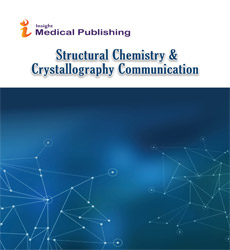PHONON ASSISTED OXYGEN DIFFUSION VS. OXYGEN AND ELECTRONIC ORDERING MECHANISMS IN NONSTOICHIOMETRIC CORRELATED OXIDES
3rd Edition of International Conference on Advanced Spectroscopy, Crystallography and Applications in Modern Chemistry
June 04-05, 2018 London, UK
Werner Paulus
University of Montpellier, France
Keynote: Struct Chem Crystallogr Commun
DOI: 10.21767/2470-9905-C1-004
Abstract
Transition Metal Oxides with strongly correlated electrons have been studied intensively due their interesting physical properties. This includes colossal magnetoresistance (CMR) where huge variations in resistance are achieved just by small changes in the applied magnetic field, or high temperature superconductivity (HTC) to name two of them [3-6]. These materials are characterized by the existence of several competing states such as charge, spin and orbital ordering, interacting in a synergetic way and leading to fairly complex phase diagrams. Thereby the physical properties can be tuned in a wide range via hole doping, e.g. by cation substitution as is the case for RE2-xSrxMO4.An alternative way of hole doping presents oxygen intercalation, generally proceeding at ambient temperature via a topotactic oxygen uptake along shallow potential diffusion pathways. Contrary to the cation substitution, requiring high reaction temperatures, oxygen intercalation reactions allow the controlled synthesis of strongly correlated oxides far away from thermodynamic equilibrium, essentially resulting in kinetically stabilized and thus metastable phases. Low temperature reactivity of solids may thus be used as a concept, to investigate the limits of available structural and electronic complexity in transition metal oxides. The reaction pathway to insert oxygen at low temperatures in solid oxides becomes a decisive parameter to tune correlations, leading to extremely complex phase relations as physical and structural properties are not only depending on the overall stoichiometry, but decisively on the sample history. Taking these oxides as oxygen ‘sponges’ operating at low reaction temperatures down to ambient, structural and electronic correlation lengths could then be influenced by the reaction conditions and kinetics. We here discuss here the challenges, low temperature solid state reactivity implies for the synthesis of new complex oxides but equally the current understanding of the relying oxygen diffusion mechanisms, having a huge fundamental and technological interest.Recent Publications 1. From T to T’-La2CuO4 via Oxygen Vacancy Ordered La2CuO3.5, M. Ikbel Houchati, M. Ceretti, C. Ritter and W. Paulus, Chem. Mater. 2012, 24, 3811-3815 2. One-dimensional oxygen diffusion mechanism in Sr2ScGaO5 electrolyte explored by neutron and synchrotron diffraction, 17O-NMR and DFT calculations, S. Corallini M. Ceretti, G. Silly, A. Piovano, S. Singh, J. Stern, C. Ritter, J. Ren, H. Eckert, K. Conder, Wei-tin Chen, Fang-Cheng Chou, N. Ichikawa, Y. Shimakawa, W. Paulus, J. Phys. Chem. C, 2015, 119 (21), 11447–11458
3. Low temperature oxygen diffusion mechanisms in Nd2NiO4+∂ and Pr2NiO4+∂ via large anharmonic displacements, explored by single crystal neutron diffraction, M. Ceretti, O. Wahyudi, A. Cousson, A. Villesuzanne, M. Meven, B. Pedersen, J.-M. Bassat, W. Paulus, JOURNAL OF MATERIALS CHEMISTRY A, 3, 42 (2015) p21140-48 4. Solid-state reactivity explored in situ by synchrotron radiation on single crystals: from SrFeO2.5 to SrFeO3 via electrochemical oxygen intercalation, A. Maity, B. Penkala, R. Dutta, M. Ceretti, A. Lebranchu, D. Chernyshov, A. Perichon, A. Piovano, A. Bossak, M. Meven, W. Paulus, J Physics D: Applied Physics, Special issue: 100 years of crystallography: new dimensions offered by large scale facilities, J. Phys. D: Appl. Phys. 48 (2015) 5. Positional Recurrence Maps: a powerful tool to decorrelate static and dynamical disorder in distribution maps from molecular dynamics simulations, Piovano, Andrea, Perrichon, Adrien, Boehm, Martin, Johnson, Mark, Paulus, Werner, Physical Chemistry Chemical Physics, 2016, 6. Anisotropic Oxygen Diffusion Properties in Pr2NiO4+δ and Nd2NiO4+δ Single Crystals, J-M Bassat, M. Burriel,
O. Wahyudi, M. Ceretti, P. Veber, I. Weill, A. Villesuzanne, J-C Grenier, W. Paulus, and John A. Kilner, J PhysChemC, 2013, 117, 26466−26472, 7. A. Perrichon, A. Piovano, M. Boehm, M. Zbiri, M. Johnson, H. Schober, M. Ceretti and W. Paulus, Lattice Dynamics Modified by Excess Oxygen in Nd2NiO4+δ:, Triggering Low-Temperature Oxygen Diffusion, J. Phys. Chem. C 2015, 119, 1557-1564.
Biography
Werner Paulus is exploring low temperature oxygen diffusion mechanisms in transition metal oxides. Oxygen doping, via topotactic reaction mechanisms while proceeding at ambient temperature is a powerful tool to access structural and electronic complexity in a controlled way. It also allows to better explore the underlying diffusion mechanisms on an atomic scale, having huge importance in solid state ionics, e.g. for the optimisation of battery materials, fuel cell membranes/electrolytes or sensors. Research activities cover synthesis methods from powder to large single crystals and to explore oxygen intercalation reactions in especially dedicated electrochemical cells on single crystals and polycrystalline electrodes by neutron and X-ray diffraction (synchrotron & laboratory), spectroscopy (XAFS, Raman, INS, IXS, NMR) combined with 18O/16O oxygen isotope exchange reactions and sophisticated data analysis (Maximum Entropy, twinning).
Email:werner.paulus@umontpelllier.fr
Google Scholar citation report
Citations : 275
Abstracted/Indexed in
- Google Scholar
- China National Knowledge Infrastructure (CNKI)
- Directory of Research Journal Indexing (DRJI)
- WorldCat
- Geneva Foundation for Medical Education and Research
- Secret Search Engine Labs
- CAS (Chemical Abstracting Services)
Open Access Journals
- Aquaculture & Veterinary Science
- Chemistry & Chemical Sciences
- Clinical Sciences
- Engineering
- General Science
- Genetics & Molecular Biology
- Health Care & Nursing
- Immunology & Microbiology
- Materials Science
- Mathematics & Physics
- Medical Sciences
- Neurology & Psychiatry
- Oncology & Cancer Science
- Pharmaceutical Sciences

